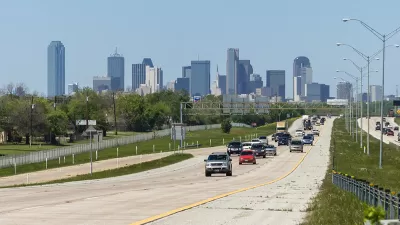Some commentators argue that sprawl is an inevitable result of affluence, based on European development patterns. These pundits tell a simple story: European urban cores are losing population and becoming more automobile-dependent - just like American cities. So if Europe can’t beat sprawl, neither can America.
Some commentators argue that sprawl is an inevitable result of affluence, based on European development patterns. These pundits tell a simple story: European urban cores are losing population and becoming more automobile-dependent - just like American cities. So if Europe can't beat sprawl, neither can America.
But in fact, this theory is based on questionable factual assumptions. To be sure, many European cores did lose population in the late 20th century. But in recent years, European cores have rebounded. Between 1991 and 2004, 15 of 27 European national capitals gained population. (1) Among the eleven European cities with over 1 million people, six (Vienna, London, Paris, Hamburg, Munich, and Madrid) gained population.(2)
Moreover, European transit ridership is in fact growing. In all five of the largest Western European nations (Germany, Spain, France, Italy and the U.K.) kilometer-miles of bus and train travel grew between 1995 and 2003- in four cases (all but Germany) by between 12 and 33 percent.(3) By contrast, population in these countries increased by 6 percent or less. (4) Even if one measures automobile dependence by market share, the results are more ambiguous than pro-sprawl pundits suggest: in the fifteen nations originally comprising the European Union, the automobile's market share has fluctuated between 84.3 and 85 percent every year since 1994- hardly a rapid increase in car dependency. (5) And in France and the United Kingdom, the "automobile market share" actually declined.
Admittedly, these trends differ from the more sprawling trends of the late 20th century. But to the extent Europe did sprawl, those results may have been a result not of the free market or affluence, but a result of pro-sprawl government policies. European highway networks expanded enormously in the late 20th century; for example, Spain's road network expanded from 387 miles to 11,432 miles between 1970 and 2005.(6) In the short run, highways make driving easier and may shift development to places with minimal transit service. In the absence of such pro-sprawl policies, Europe might have sprawled less.
But today, the tide of European sprawl is ebbing- thus indicating that sprawl is not as inevitable as some think.
(1) EUROPEAN COMMISSION, EUROSTAT REGIONAL YEARBOOK 2007 at 77.
(2) For detailed statistics go to www.citypopulation.de
(3) See Eurostat, Transport Tables, available at http://epp.eurostat.ec.europa.eu/portal/page?_pageid=1996,45323734&_dad… (click on links for "Rail transport of passengers" and "Bus transport of passengers, and add links together")
(4) See U.S. Census Bureau, 2004-05 Statistical Abstract at 841-43.
(5) See Eurostat Transport Tables, supra note 3 (click on link for "Car share of inland passenger transport").
(6) European Union, Statistical Pocketbook 2007, Part 3.5.1, available at http://ec.europa.eu/dgs/energy_transport/figures/pocketbook/doc/2007/2007_transport_en.pdf (visited March 11, 2008).

Study: Maui’s Plan to Convert Vacation Rentals to Long-Term Housing Could Cause Nearly $1 Billion Economic Loss
The plan would reduce visitor accommodation by 25,% resulting in 1,900 jobs lost.

North Texas Transit Leaders Tout Benefits of TOD for Growing Region
At a summit focused on transit-oriented development, policymakers discussed how North Texas’ expanded light rail system can serve as a tool for economic growth.

Using Old Oil and Gas Wells for Green Energy Storage
Penn State researchers have found that repurposing abandoned oil and gas wells for geothermal-assisted compressed-air energy storage can boost efficiency, reduce environmental risks, and support clean energy and job transitions.

Private Donations Propel Early Restoration of Palisades Playground
Los Angeles has secured over $1.3 million in private funding to restore the Pacific Palisades playground months ahead of schedule, creating a modern, accessible space that supports community healing after recent wildfires.

From Blight to Benefit: Early Results From California’s Equitable Cleanup Program
The Equitable Community Revitalization Grant (ECRG) program is reshaping brownfield redevelopment by prioritizing projects in low-income and environmental justice communities, emphasizing equity, transparency, and community benefits.

Planting Relief: Tackling Las Vegas Heat One Tree at a Time
Nevada Plants, a Las Vegas-based nonprofit, is combating the city’s extreme urban heat by giving away trees to residents in underserved neighborhoods, promoting shade, sustainability, and community health.
Urban Design for Planners 1: Software Tools
This six-course series explores essential urban design concepts using open source software and equips planners with the tools they need to participate fully in the urban design process.
Planning for Universal Design
Learn the tools for implementing Universal Design in planning regulations.
Ascent Environmental
Borough of Carlisle
Institute for Housing and Urban Development Studies (IHS)
City of Grandview
Harvard GSD Executive Education
Toledo-Lucas County Plan Commissions
Salt Lake City
NYU Wagner Graduate School of Public Service




























